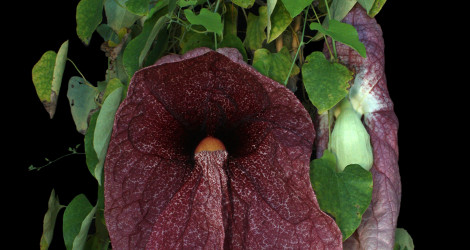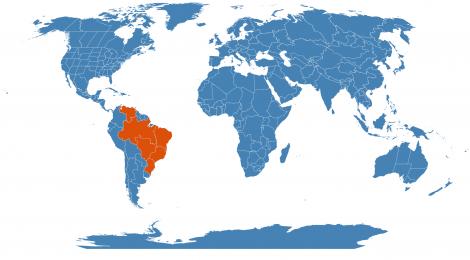Accession Data:
Aristolochia gigantea Mart. & Zucc.
- Common Name: Brazilian Dutchman's Pipe
- Family: Aristolochiaceae Juss.
- Description: The flowers grow in the leaf axils. They are inflated and globose at the base, continuing as a long calyx and corolla of a flower (generally used when the two are similar).">perianth tube, ending in a tongue-shaped, brightly colored lobe. There is no corolla.
These flowers have a specialized pollination mechanism. The plants are aromatic and their scent attracts insects. The inner part of the perianth tube is covered with hairs, acting as a fly-trap. These hairs then wither to release the fly, covered with pollen.2
Botanical Description available on pg 159 of Revi sion of the North and Central American Hexandrous Species of Aristolochia (Aristolochiaceae), Howard W. Pfeifer, Annals of the Missouri Botanical Garden, Vol. 53, No. 2. (1966), pp. 115-196. {JSTOR archive, subscription may be required}
- USDA Zone: 10a-11
Accession Data:
- Accession # 200201892
- Source: Doug Goldman - Cornell
- Provenance: Plant from Doug Goldman (Cornell). This clone is supposedly a South American clone with true 'giant' flowers up to 18" in length. Older accession in our collections may presumably be a smaller flowered Central American Clone as its flowers only reach a maximum of 6 inches in length.
- Accession Date: 09-09-2002
- Bench: 3113 - EVO: Gnetum
- Currently: active - healthy
- Qty: 2 confirmed on 03-17-2025
Classification:
- Division: Magnoliophyta
- Class: Magnoliopsida
- SubClass: magnoliids
- Order: Piperales
- SubOrder:
- Family: Aristolochiaceae
- SubFamily: Aristolchioideae
- Tribe: Aristolochieae
- SubTribe:
Flowering Data:
This accession has been observed in bloom on:| Year | Jan | Feb | Mar | Apr | May | Jun | Jul | Aug | Sep | Oct | Nov | Dec | ||||||||||||||||||||||||||||||||||||||||
|---|---|---|---|---|---|---|---|---|---|---|---|---|---|---|---|---|---|---|---|---|---|---|---|---|---|---|---|---|---|---|---|---|---|---|---|---|---|---|---|---|---|---|---|---|---|---|---|---|---|---|---|---|
| 2025 | ||||||||||||||||||||||||||||||||||||||||||||||||||||
| 2024 | ||||||||||||||||||||||||||||||||||||||||||||||||||||
| 2023 | ||||||||||||||||||||||||||||||||||||||||||||||||||||
| 2022 | ||||||||||||||||||||||||||||||||||||||||||||||||||||
| 2021 | ||||||||||||||||||||||||||||||||||||||||||||||||||||
| 2020 | ||||||||||||||||||||||||||||||||||||||||||||||||||||
| 2019 | ||||||||||||||||||||||||||||||||||||||||||||||||||||
| 2018 | ||||||||||||||||||||||||||||||||||||||||||||||||||||
| 2017 | ||||||||||||||||||||||||||||||||||||||||||||||||||||
| 2016 | ||||||||||||||||||||||||||||||||||||||||||||||||||||
| 2015 | ||||||||||||||||||||||||||||||||||||||||||||||||||||
| 2014 | ||||||||||||||||||||||||||||||||||||||||||||||||||||
| 2013 | ||||||||||||||||||||||||||||||||||||||||||||||||||||
| 2012 | ||||||||||||||||||||||||||||||||||||||||||||||||||||
| 2011 | ||||||||||||||||||||||||||||||||||||||||||||||||||||
| 2010 | ||||||||||||||||||||||||||||||||||||||||||||||||||||
| 2009 | ||||||||||||||||||||||||||||||||||||||||||||||||||||
| 2008 | ||||||||||||||||||||||||||||||||||||||||||||||||||||
| 2007 | ||||||||||||||||||||||||||||||||||||||||||||||||||||
| 2006 | ||||||||||||||||||||||||||||||||||||||||||||||||||||
| 2005 | ||||||||||||||||||||||||||||||||||||||||||||||||||||
| 2004 | ||||||||||||||||||||||||||||||||||||||||||||||||||||
| 2003 | ||||||||||||||||||||||||||||||||||||||||||||||||||||
References (internal):
- Basal Angiosperms (paleodicots)
- Fly pollination (myophily and sapromyophily)
- EEB 3271 - Systematic Botany
- EEB 3203 - Developmental Plant Morphology
- Pollination Syndrome Scavenger Hunt
- Scavenger Hunt - Grades 9-12
- EEB Greenhouse Holdings native to: Venezuela / Brazil West-Central / Brazil Northeast / Brazil Southeast / Brazil North / Brazil South
References (external):
- Revision of the North and Central American Hexandrous Species of Aristolochia (Aristolochiaceae), Howard W. Pfeifer, Annals of the Missouri Botanical Garden, Vol. 53, No. 2. (1966), pp. 115-196. {JSTOR archive, subscription may be required}
- Wikipedia. Accessed 2 April 2015.
- The Plant List (2013). Version 1.1. Last accessed on Friday, September 01, 2017.
- Aristolochia gigantea at Global Biodiversity Information Facility. Last accessed on Friday, September 01, 2017.
data regenerated on Mon, 24 Mar 2025 08:39:27 -0400 [bcm v4.0]
Images:

Additional images for this accession:
Click on thumbnails to enlargeCurrent Accessions in the Aristolochiaceae
Subfamily Aristolchioideae
Tribe Aristolochieae
- Aristolochia arborea


- Aristolochia californica

- Aristolochia chilensis
- Aristolochia fimbriata

- Aristolochia gigantea


- Aristolochia littoralis


- Aristolochia ringens


Subfamily Asaroideae
Tribe Sarumeae
W/C = Wild Collected
 = indicates flowering in past 14 days
= indicates flowering in past 14 days
 = images available for this accession
= images available for this accession
 = map available for this accession
= map available for this accession
 = accession added within past 90 days
= accession added within past 90 days




